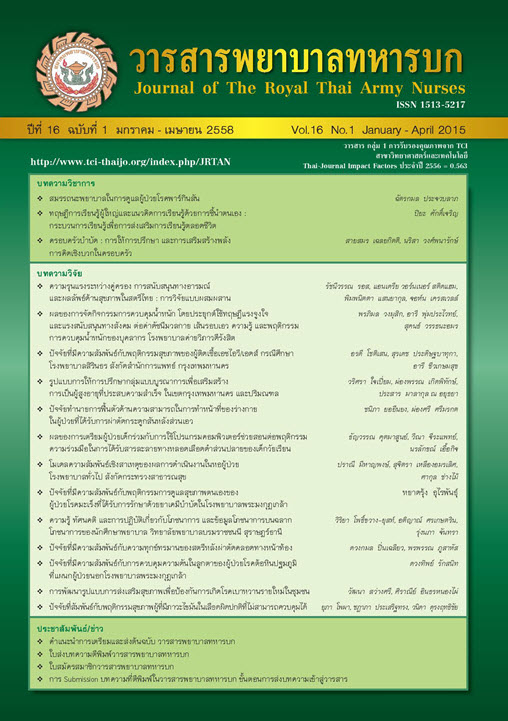ปัจจัยที่มีความสัมพันธ์กับการควบคุมความดันในลูกตาของผู้ป่วยโรคต้อหิน ปฐมภูมิที่แผนกผู้ป่วยนอกโรงพยาบาลพระมงกุฎเกล้า Factors Associated with Intra-ocular Pressure Control, Primary Glaucoma Patients at Out Patient Department of Phramongkutklao Hospital
Keywords:
ปัจจัยที่มีความสัมพันธ์, ความดันในลูกตา, ผู้ป่วยโรคต้อหินปฐมภูมิ, Factor Associated, Intraocular Pressure, Primary Glaucoma PatientsAbstract
การวิจัยนี้มีวัตถุประสงค์ เพื่อศึกษาปัจจัยที่มีความสัมพันธ์กับการควบคุมความดันในลูกตาของผู้ป่วยโรคต้อหินปฐมภูมิ ใช้รูปแบบการวิจัยเชิงวิเคราะห์ (Observational Analytic studies) ชนิดไม่จับคู่ ป่วย - ไม่ป่วย (Unmatched case-control study) ศึกษากับผู้ป่วยโรคต้อหินปฐมภูมิที่แผนกผู้ป่วยนอก โรงพยาบาลพระมงกุฎเกล้า จำนวน 214 คน จำแนกเป็น กลุ่มศึกษา 107 คน และกลุ่มควบคุม 107 คน เก็บรวบรวมข้อมูลด้วยแบบสอบถาม วิเคราะห์ข้อมูลด้วยสถิติเชิงพรรณนา (Descriptive statistics) ได้แก่ ค่าเฉลี่ย ส่วนเบี่ยงเบนมาตรฐาน และร้อยละ และสถิติเชิงอนุมาน (Inferential statistics) โดยใช้การทดสอบ ไคสแควร์ (Chi-square test) อัตราความเสี่ยง (Odds ratio) และวิเคราะห์การถดถอยพหุลอจิสติก (Multiple logistic regression)ผลการศึกษาพบว่าปัจจัยที่มีความสัมพันธ์กับการควบคุมดันในลูกตาของผู้ป่วยต้อหินปฐมภูมิ ได้แก่ การใช้ยาสเตียรอยด์ ต่อเนื่องติดต่อกันนานตั้งแต่ 2 สัปดาห์ขึ้นไป (ORadj = 24.31, 95% CI: 2.87-206.17, p = 0.003) การหยอดตาด้วยตนเอง (ORadj = 2.68, 95%CI: 1.06-6.78, p = 0.03) ระยะเวลาการเป็นโรคต้อหินตั้งแต่ 3 ปีขึ้นไป (ORadj = 3.29, 95%CI: 1.55-6.99, p = 0.002) ระยะการดำเนินของโรคระยะรุนแรง (Advance Glaucoma) (ORadj = 7.02, 95% CI: 3.05-16.11, p < 0.001) และประวัติบุคคลในครอบครัวเป็นโรคต้อหิน (ORadj = 2.67, 95%CI: 1.12-6.51, p = 0.027)
จากการศึกษาครั้งนี้แสดงให้เห็นถึงปัจจัยที่มีความสัมพันธ์กับการควบคุมความดันในลูกตาของผู้ป่วยโรคต้อหินปฐมภูมิ ดังนั้นผู้ป่วยโรคต้อหินปฐมภูมิ ควรระมัดระวังในปัจจัยดังกล่าว โดยเน้นการปรับเปลี่ยนพฤติกรรมการใช้ยาสเตียรอยด์ และการ หยอดยาด้วยตนเองของผู้ป่วย ส่วนบุคลากรทางการแพทย์ควรให้ความสนใจกับประวัติการเป็นโรคต้อหินของบุคคลในครอบครัว ระยะเวลาการเป็นโรคต้อหิน และระยะการดำเนินของโรคต้อหิน เพื่อประสิทธิภาพในการรักษาให้ดียิ่งขึ้น
This research aimed to study the factors which associated with the intraocular pressure control of primary glaucoma patients. Observational Analytic studies with unmatched case-control study were conducted to 214 primary glaucoma patients at outpatient department of Phramongkutklao Hospital. The samples were divided into 107 cases and 107 controls. Data were collected by a questionnaire and analyzed by descriptive statistics, including mean, standard deviation and percentages and inferential statistics by using chi-square test, odds ratio, and multiple logistic regression.
The study found that the factors which associated with the intraocular pressure control were using steroids up 2 weeks (ORadj= 24.31, 95% CI: 2.87-206.17, p = 0.003), giving yourself eye drops. (ORadj= 2.68, 95% CI: 1.06-6.78., p = 0.03), being up three years periods with primary glaucoma (ORadj = 3.29, 95% CI: 1.55-6.99, p = 0.002), being advanced primary glaucoma (ORadj= 7.02, 95% CI: 3.05-16.11, p <0.001), and family history of glaucoma (ORadj = 2.67, 95% CI: 1.12-6.51, p = 0.027).
The finding of this research highlighted some major risk factors which associated with intra ocular pressure of primary glaucoma patients. Therefore, primary glaucoma patients and health care teams should concern with those factors by emphasizing on the behavior changing of using steroids and self-eye drop medication. Medical staff should concern with person’s family history of glaucoma, period of glaucoma, and stage of primary glaucoma in order to increase the effectiveness of glaucoma treatment.
Downloads
Downloads
How to Cite
Issue
Section
License
บทความหรือข้อคิดเห็นใดใดที่ปรากฏในวารสารพยาบาลทหารบกเป็นวรรณกรรมของผู้เขียน ซึ่งบรรณาธิการหรือสมาคมพยาบาลทหารบก ไม่จำเป็นต้องเห็นด้วย
บทความที่ได้รับการตีพิมพ์เป็นลิขสิทธิ์ของวารสารพยาบาลทหารบก
The ideas and opinions expressed in the Journal of The Royal Thai Army Nurses are those of the authors and not necessarily those
of the editor or Royal Thai Army Nurses Association.






